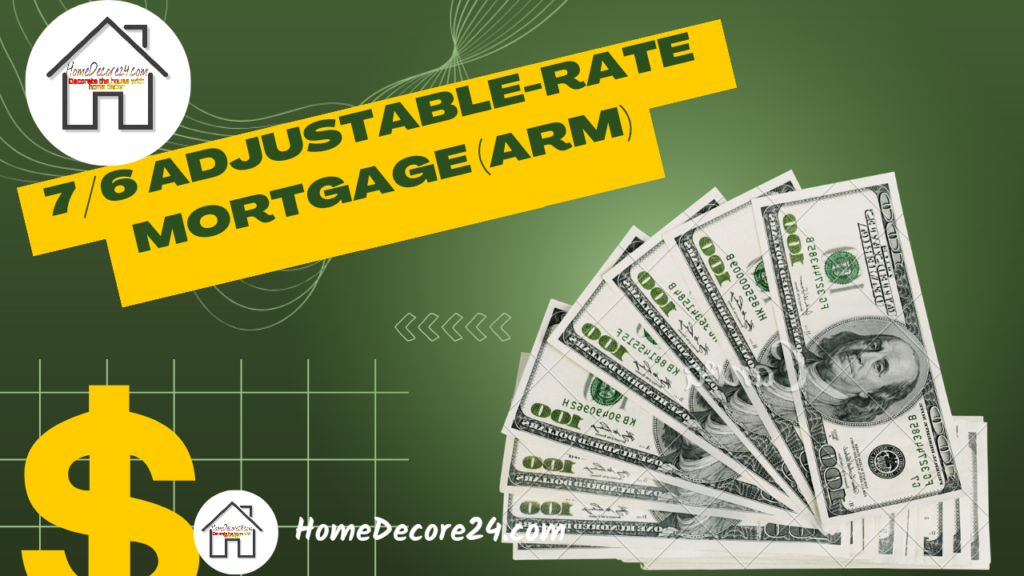
The realm of mortgage financing offers borrowers various options tailored to their financial goals and circumstances. One such option is the 7/6 Adjustable-Rate Mortgage (ARM), a unique loan product that combines both fixed and adjustable interest rates. In this article, we will delve into the details of what a 7/6 ARM is, how it works, its pros and cons, and considerations for potential borrowers.
What is a 7/6 ARM?
A 7/6 ARM is a mortgage with a fixed interest rate for the initial 7 years, followed by an adjustable rate that changes every 6 months for the remaining 6 years. It offers lower initial rates but brings payment uncertainty during the adjustable phase based on market conditions.
Definition of a 7/6 ARM
The 7/6 ARM is a type of mortgage that carries a fixed interest rate for the initial seven years, followed by an adjustable rate for the remaining six years of the loan term. This structure is represented by the “7/6” notation, where the first number denotes the fixed period (7 years), and the second number indicates the frequency of rate adjustments during the adjustable phase (every 6 months).
Read More: Jumbo vs. Conventional Loans
How a 7/6 ARM Works
Initial Fixed Period (7 years)
During the initial seven years, borrowers enjoy the stability of a fixed interest rate. This means that their monthly mortgage payments remain constant over this period, providing predictability and budgeting ease.
Transition to Adjustable Period
After the initial fixed period expires, the mortgage transitions into the adjustable phase. At this point, the interest rate becomes variable and can change every six months based on the index it is tied to, such as the London Interbank Offered Rate (LIBOR) or the U.S. Treasury Index. The new interest rate is determined by adding a predetermined margin (a fixed percentage) to the current index value.
Rate Adjustments
The adjustable rate will be recalculated every six months according to the index’s fluctuations. This means that borrowers’ monthly payments will also change with each rate adjustment, potentially increasing or decreasing based on market conditions.
Read More: How to Recognize a Reverse Mortgage Scam
Pros And Cons Of 7/6 ARM
Pros of a 7/6 ARM
Lower Initial Rates: 7/6 ARMs typically offer lower initial interest rates compared to fixed-rate mortgages, which can lead to lower initial monthly payments.
Potential for Savings: If market interest rates remain relatively stable or decrease, borrowers could benefit from lower monthly payments during the adjustable phase.
Shorter Fixed Period: The seven-year fixed period provides a longer period of rate stability compared to shorter-term ARMs, making it an attractive option for borrowers who plan to stay in their homes for the medium term.
Cons of a 7/6 ARM
Uncertain Future Payments: The adjustable phase introduces uncertainty, as borrowers’ monthly payments can fluctuate significantly with changing interest rates, potentially leading to financial strain.
Rate Risk: If market interest rates rise during the adjustable phase, borrowers may experience substantial increases in their monthly payments, impacting their financial stability.
Refinancing Costs: If borrowers decide to refinance before the adjustable phase begins or during it, they might encounter refinancing costs that need to be factored into their decision-making.
Considerations for Borrowers
- Financial Flexibility: Borrowers should assess their financial capacity to handle potential payment fluctuations during the adjustable phase and determine if they can comfortably afford higher payments if rates rise.
- Future Plans: Borrowers should consider their future plans. If they anticipate selling the property before the adjustable phase begins, the potential rate fluctuation might not be a significant concern.
- Market Trends: Researching and understanding current interest rate trends and economic forecasts can provide insights into potential rate movements during the adjustable phase.
FAQ’s
What are the advantages of a 7/6 ARM?
The advantages of a 7/6 ARM include lower initial interest rates, potential savings if rates stay stable or decrease, and a longer fixed period for rate stability.
What are the disadvantages of a 7/6 ARM?
The disadvantages of a 7/6 ARM include uncertain future payments due to adjustable rates, the risk of higher payments if rates rise, and potential refinancing costs.
What does 7/6 ARM mean?
The term “7/6 ARM” signifies a mortgage with a fixed rate for 7 years, transitioning to an adjustable rate that changes every 6 months for the remaining 6 years.
What is a 6/7 month ARM?
A “6/7 month ARM” is a mortgage featuring an initial fixed rate for 6 months, then adjusting every 7 months thereafter, potentially affecting monthly payments based on market rate changes.
Youtube Video
Conclusion
The 7/6 Adjustable-Rate Mortgage (ARM) is a unique mortgage product that combines an initial fixed rate period with an adjustable rate phase. It offers lower initial rates and potential savings but comes with the risk of uncertain future payments. Borrowers should carefully assess their financial situation, future plans, and market trends before deciding if a 7/6 ARM is the right mortgage option for their needs. Consulting with a financial advisor or mortgage professional can provide valuable guidance in making an informed decision.
=>Should You Invest in Affordable Housing? Pros, Cons, and Profitability
=>The 40-Year Mortgage: Examining the Pros and Cons







